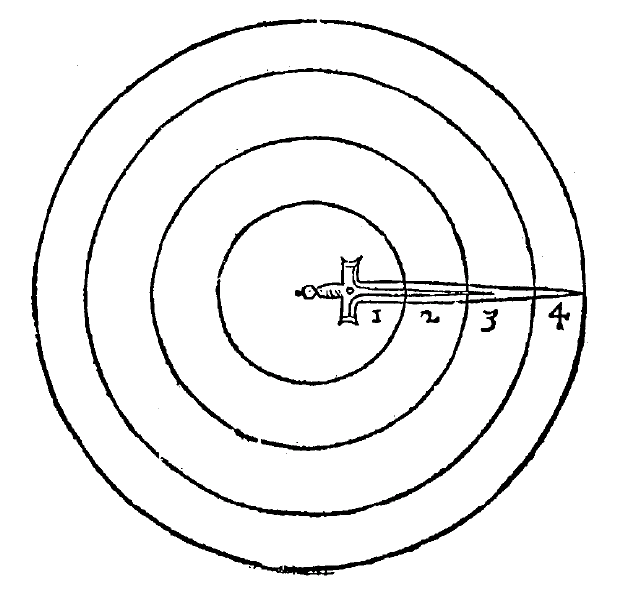5. Concerning Thrusting¶
Concerning thrusting, or the most perilous blows of the point, he must provide so to stand with his body, feet and arms, that he be not forced, when he would strike, to lose time: The which he shall do, if he stand either with his arm so forward, either with his feet so backward, either with his body so disorderly, that before he thrust he must needs draw back his arm, help himself with his feet, or use some dangerous motion of the body, the which when the enemy perceives, he may first strike before he be struck. But when a man stands in due order (which shall hereafter be declared) and perceives that there is less distance from the point of his sword unto his enemy, than there is from his enemies sword unto him, In that case he must nimbly force on a strong thrust to the end he may hit home first.
For as much as the Effects which proceed from the length of the sword, are not in every part thereof equal or of like force: It stands with reason besides the declaration of the cause, that I find out also the property and name of each part, to the end every man may understand, which are the parts of the length wherewith he ought to strike, and which the parts, wherewith he must defend.
I have said elsewhere, that the sword in striking frames either a Circle, either a part of a Circle, of which the hand is the center. And it is manifest that a wheel, which moves circularly, is more forcible and swift in the circumference than towards the Center: The which wheel each sword resembles in striking. Whereupon it seems convenient, that I divide the sword into four equal parts: of the which that which is most nearest the hand, as mostnigh to the cause, I will call the first part: the next, I will term the second, then the third, and so the fourth: which fourth part contains the point of the sword. of which four parts, the third and fourth are to be used to strike withal. For seeing they are nearest to the circumference, they are most swift. And the fourth part (I mean not the tip of the point, but four fingers more within it) is the swiftest and strongest of all the rest: for besides that it is in the circumference, which causes it to be most swift, it has also four fingers of counterpiece thereby making the motion more forcible. The other two parts, to wit, the first and second are to be used to warde withal, because in striking they draw little compass, and therefore carry with them small force And for that their place is near the hand, they are for this cause strong to resist any violence.
